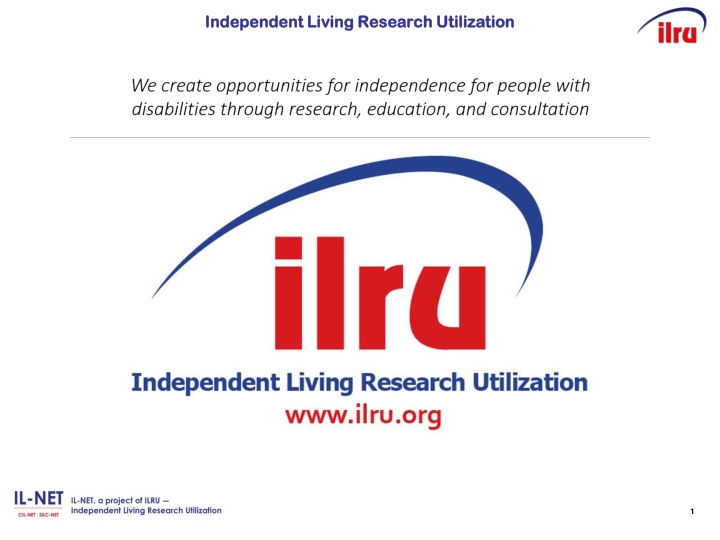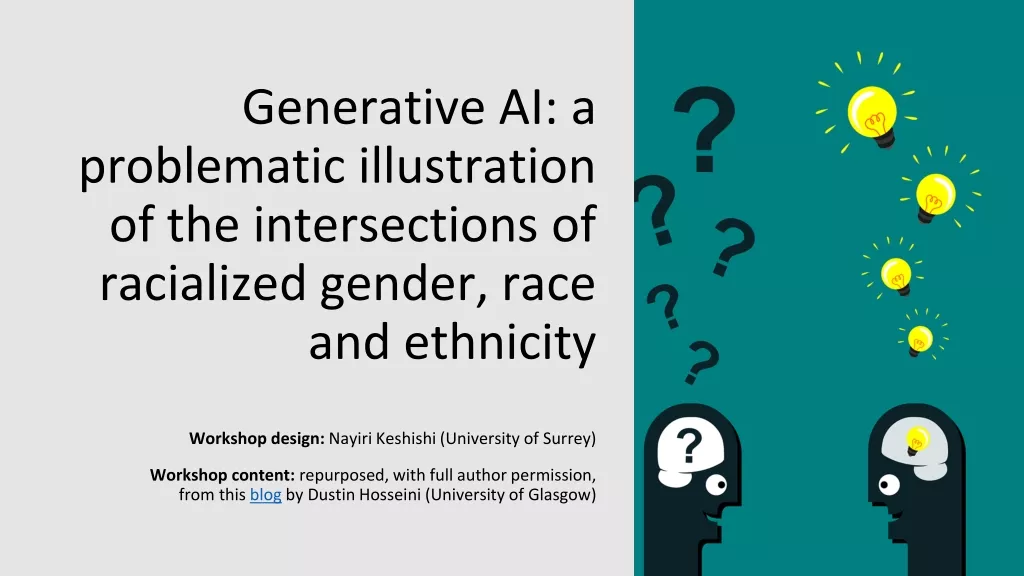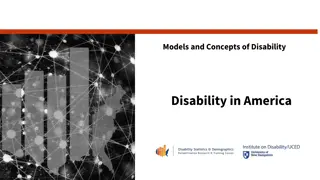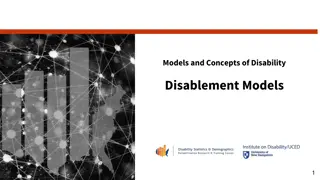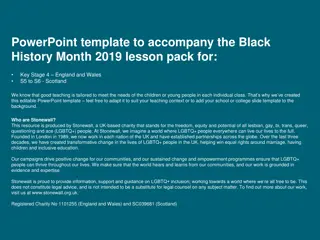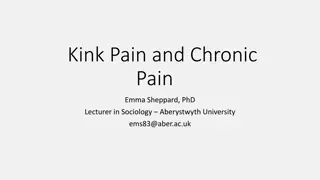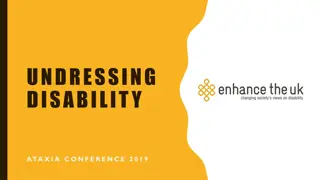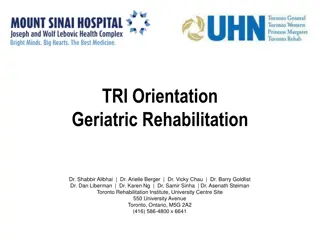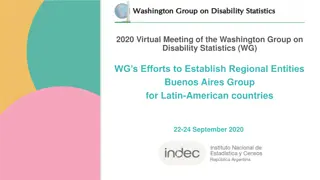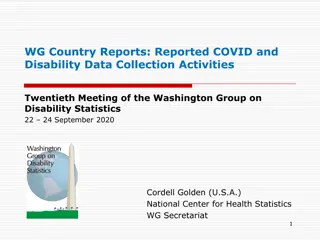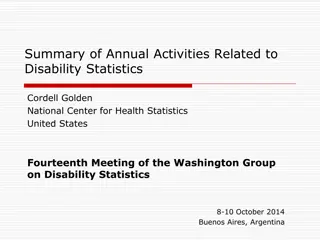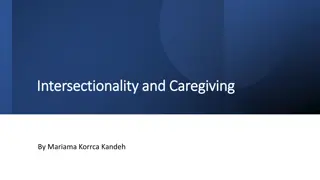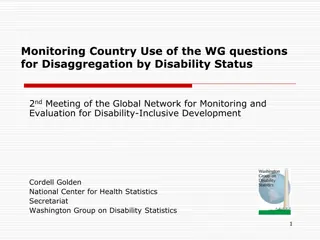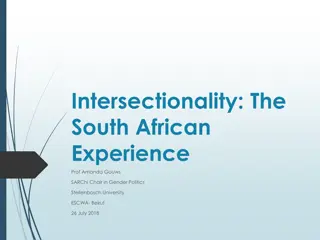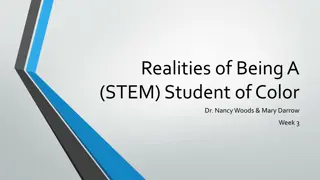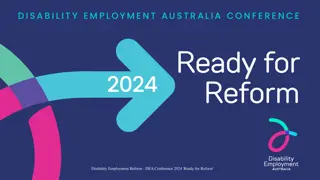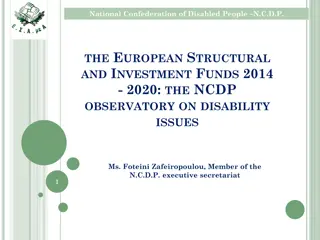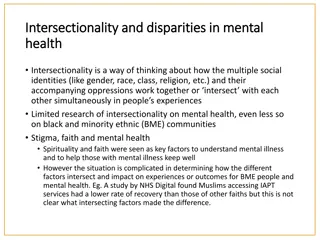Disability Intersectionality Issues in America
This content delves into the challenges faced by racially and ethnically diverse groups with disabilities in America. It highlights the findings of research studies, government reports, and the perspectives of the HHS Advisory Committee on Minority Health, shedding light on the unique circumstances and needs of traditionally underserved populations. The content emphasizes the impact of intersectionality on individuals living at the crossroads of race, ethnicity, and disability, presenting a comprehensive overview of the issues faced and the importance of culturally competent policies and practices in supporting these communities.
Download Presentation

Please find below an Image/Link to download the presentation.
The content on the website is provided AS IS for your information and personal use only. It may not be sold, licensed, or shared on other websites without obtaining consent from the author.If you encounter any issues during the download, it is possible that the publisher has removed the file from their server.
You are allowed to download the files provided on this website for personal or commercial use, subject to the condition that they are used lawfully. All files are the property of their respective owners.
The content on the website is provided AS IS for your information and personal use only. It may not be sold, licensed, or shared on other websites without obtaining consent from the author.
E N D
Presentation Transcript
Independent Living Research Utilization Independent Living Research Utilization 1
Lunch Presentation Lunch Presentation Darrell Jones & Judith Holt Darrell Jones & Judith Holt DDI Project Overview and Background DDI Project Overview and Background 2
Disability, Diversity and Disability, Diversity and Intersectionality (DDI) Project Intersectionality (DDI) Project Independent Living Research Utilization (ILRU) in collaboration with Public Research and Evaluation Services (PRES) conducted a three-phase research study entitled, Disability, Diversity and Intersectionality (DDI) project funded by the Administration for Community Living. The study was designed to determine how CILs are designing, implementing, and evaluating culturally and linguistically competent policies and practices to improve services, programs and outreach for racially/ethnically, culturally, and linguistically diverse groups. 3
Why: Why: Disability, Diversity and Disability, Diversity and Intersectionality Intersectionality The HHS Advisory Committee on Minority Health has described living as a member of a racial or ethnic minority group with a disability as a double burden due to the added sociopolitical challenges encountered (p. 1). (US Department of Health and Human Services, as cited in Blick, Franklin, Ellsworth, Havercamp & Kornblau (2015) 4
Findings of U.S. Congress: Section 21 Findings of U.S. Congress: Section 21 of the Rehabilitation Act of the Rehabilitation Act SEC. 21. TRADITIONALLY UNDERSERVED POPULATIONS. (a) FINDINGS. With respect to the programs authorized in titles II through VII, the Congress finds as follows: (1) RACIAL PROFILE. The demographic profile of America is rapidly changing. While the percentage increase for white Americans is 9.7 percent the percentage increase for racial and ethnic minorities was much higher 43.0 percent for Latinos, 12.3 percent for African-Americans, and 43.2 percent for Asian Americans and other ethnic groups. 5
Findings of U.S. Congress: Section 21 Findings of U.S. Congress: Section 21 of the Rehabilitation of the Rehabilitation Act, (2) RATE OF DISABILITY. Ethnic and racial minorities tend to have disabling conditions at a disproportionately high rate. In 2011- (A)among Americans ages 16 through 64, the rate of disability was 12.1 percent; (B) among African-Americans in that age range, the disability rate was more than twice as high, at 27.1 percent; (C) for American Indians and Alaskan Natives in the same age range, the disability rate was also more than twice as high, at 27.0 percent. Act, cont d. 6
Findings of U.S. Congress: Section 21 Findings of U.S. Congress: Section 21 of the Rehabilitation of the Rehabilitation Act, Act, cont d. 2 (3) INEQUITABLE TREATMENT. Patterns of inequitable treatment of minorities have been documented in all major junctures of the vocational rehabilitation process. As compared to white Americans, a larger percentage of African-American applicants to the vocational rehabilitation system is denied acceptance. Of applicants accepted for service, a larger percentage of African-American cases is closed without being rehabilitated. Minorities are provided less training than their white counterparts. Consistently, less money is spent on minorities than on their white counterparts. 7
Findings of U.S. Congress: Section 21 Findings of U.S. Congress: Section 21 of the Rehabilitation of the Rehabilitation Act, (4) RECRUITMENT. Recruitment efforts within vocational rehabilitation at the level of preservice training, continuing education, and in-service training must focus on bringing larger numbers of minorities into the profession in order to provide appropriate practitioner knowledge, role models, and sufficient manpower to address the clearly changing demography of vocational rehabilitation. Act, cont d. 3 cont d. 3 8
Title VII Title VII Outreach to Unserved and Outreach to Unserved and Underserved Underserved Section 725. Standards and Assurances for Centers for Independent Living. (C) ASSURANCES. The eligible agency shall provide at such time and in such manner as the Administrator may require, such satisfactory assurances as the Administrator may require, including satisfactory assurances that (10) aggressive outreach regarding services provided through the center will be conducted in an effort to reach populations of individuals with significant disabilities that are unserved or underserved by programs under this title, especially minority groups and urban and rural populations; (11) Staff at CILs will receive training on how to serve such unserved and underserved populations . 9
Sites Selected for Case Sites Selected for Case Studies Studies Access Living (Chicago, Illinois) Marca Bristo Center for Independence of the Disabled in New York (Manhattan, New York) Susan Dooha Central Coast Center for Independent Living (Salinas, California) Elsa Quezada Central Iowa Center for Independent Living (Des Moines, Iowa) Reyma McCoy McDeid Community Resources for Independent Living (Hayward, California) Ron Halog 10
Sites Selected for Case Sites Selected for Case Studies, Studies, cont d. disABILITY LINK (Tucker, Georgia) Kim Gibson Illinois/Iowa Independent Living Center (Illinois/Iowa: Rock Island, Illinois) Liz Sherwin IndependenceFirst (Milwaukee, Wisconsin) Lee Schulz Metropolitan Center for Independent Living (St. Paul, Minnesota) Jesse Bethke Gomez 11
Project Webpage Project Webpage www.CIL www.CIL- -diversity.org diversity.org You will find: Background and purpose of the Disability, Diversity & Intersectionality project Nine CIL Case Studies On-demand webinars in the series Slide presentations from NCIL and APRIL workshops 12
DDI Project: Definitions Used DDI Project: Definitions Used Diversity: Differences in culture, ethnic or racial classification, self-identification, tribal or clan affiliation, nationality, language, age, gender, sexual orientation, gender identity or expression, socioeconomic status, education, religion, spirituality, physical and intellectual abilities, personal appearance and other factors that distinguish one group or individual from another. (Adapted from Goode & Jackson, 2009) Intersectionality: The multiple social group memberships and identities that expose an individual to different types of discrimination and disadvantage. (Sue, Rasheed and Rasheed, 2016) 13
The DDI Project The DDI Project The DDI project included the following steps 1. Developed a list of CILs that were identified through interviews and a focus group. 2. Contacted 38 CILs who had been nominated to gather further information. 3. Completed 20 telephone interviews regarding their interest and eligibility. 4. Interviews were reviewed and rated by a panel. 5. Nine (9) CILs were selected for in-depth case studies. 14
The Journey of 9 CILs: The Journey of 9 CILs: Some Learned Learned Case study CILs were hesitant about being seen as exemplary. Shared their story, understanding that it is about the progress on an ongoing journey. The journey is a moving target (changing demographics, change-over of staff, board terms). Your CIL must Know your community. Do your homework be responsive to who the community is and what they want. Be proactive as well as responsive. Be intentional and thoughtful. Some Lessons Lessons 15
The Journey of 9 CILs: The Journey of 9 CILs: Some Learned, Learned, cont d. You will need to rethink/restructure aspects of how your CIL functions board, staff, core services, outreach. The journey involves new partners and often moving outside your comfort zone. The process that your CIL engages in to meet the needs of a specific population can be applied to other marginalized groups. As you gain new insights, knowledge, and skills, you can achieve positive outcomes and ensure that your CIL represents and includes ALL. Some Lessons Lessons 16
Contact Contact Darrell Lynn Jones dljones@bcm.edu 17
CIL CIL- -NET Attribution NET Attribution This project is supported by grant number 90ILTA0001 from the U.S. Administration for Community Living, Department of Health and Human Services, Washington, D.C. 20201. Grantees undertaking projects under government sponsorship are encouraged to express freely their findings and conclusions. Points of view or opinions do not, therefore, necessarily represent official Administration for Community Living policy. 18 18
